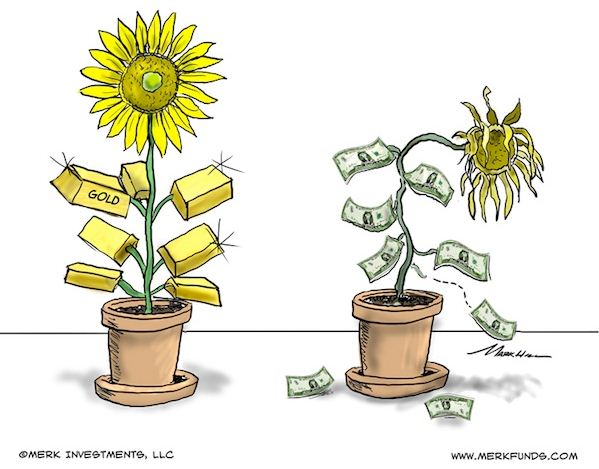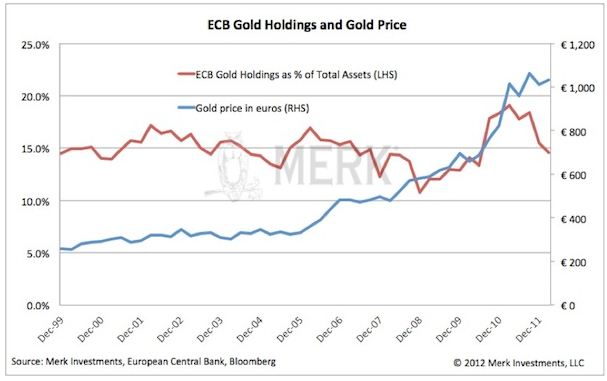When the euro was launched, the European Central Bank (ECB) held approximately 15% of its assets in gold. That ratio has remained reasonably stable, giving rise to a variety of chatter, including suggestions that it may displace the U.S. dollar. We pursue the question on whether the ECB’s gold holdings are an accident or strategy.
Let’s look at the numbers. Below is a chart depicting the percentage of gold relative to the ECB’s total assets. As one can see, the percentage has remained reasonably stable despite a significant growth in total assets.
Total assets of a central bank may be considered a proxy for the amount of money that has been “printed”; it’s a crude measure as it does not reflect physical money printed; nor does it reflect money in circulation; neither does it reflect sterilization activities that also show a rise in assets. Still, a central bank balance sheet is often referred to as the printing press as money is literally created out of thin air (by the stroke of a keyboard) when assets are purchased. Federal Reserve (Fed) Chairman Bernanke has referred to this fiat money feature as the printing press. We like to think of it as super-money, as central bank purchases provide cash to the banking system, allowing them to lend a multiple of the money that has been “printed”. While banks have been reluctant to lend (the velocity of money has been low), the analogy we like to give is that if you give a baby a gun, just because no one gets hurt does not mean it is not dangerous. That said, let’s look at total assets at the ECB:
The interpretation shows that while money can be printed, wealth cannot be created out of thin air: as money is printed, gold has appreciated versus the euro. So while inflation has not shown up in indicators such as the Consumer Price Index, monetary easing is rightfully reflected in the price of gold.
Diving a little deeper to determine how much of this is strategy versus accident, let’s look at the gold holdings at the ECB once more:
The ECB marks its gold holdings to market, i.e. uses market prices for gold. The ECB was selling gold from the inception of the euro until the onset of the financial crisis; since then, the ECB’s gold holdings have remained stable. To understand the motivation, one needs to note that when one refers to ECB gold holdings, one is actually talking about Euro area gold holdings. While the ECB holds some gold, most gold is held by the respective central banks (this is not a discussion of where such gold is physically located):
Relevant is that each nation in the Eurozone pursues its own agenda with regard to its gold holdings. Germany has resisted political pressure within Germany to sell gold, as Bundesbank (Buba) profits would need to be transferred to the government; the hawkish Buba has indicated that it would be considered selling gold to help finance the government’s deficit. Italy, as one can see, has not sold any gold. Conversely, as a percentage of their holdings, the Netherlands had been rather eager to sell gold up until the financial crisis; Portugal, too, was an aggressive seller. As one can see, gold sales are not particularly related to the financial health of a Eurozone nation, but more to the cultural attitude in the respective nations towards gold.
Let’s cross the Atlantic to see whether the ECB’s gold strategy is undermining the U.S. dollar. The Fed’s gold stock is valued at .22 per fine troy ounce. For purposes of the chart below, we adjust the Fed’s gold holdings to market prices:
Note that the chart above starts in 2006, so as to focus on the period of the financial crisis. The Fed has been more aggressive than the ECB in printing money. As such, the percentage of gold in relation to total holdings has declined at the Fed in a more pronounced fashion. There is clearly no perfect relationship between the size of the balance sheet and the price of gold, as other factors also influence the supply and demand of gold; however, increasing the supply of fiat money (dollar, euros) may decrease its value when measured in real assets, such as gold. We have in the past referred to the Fed as the champ in printing money (as measured by the percentage balance sheet growth since August 2008), although the Bank of England has, as of late, taken on that title. But we digress.
Source: Merk Funds











